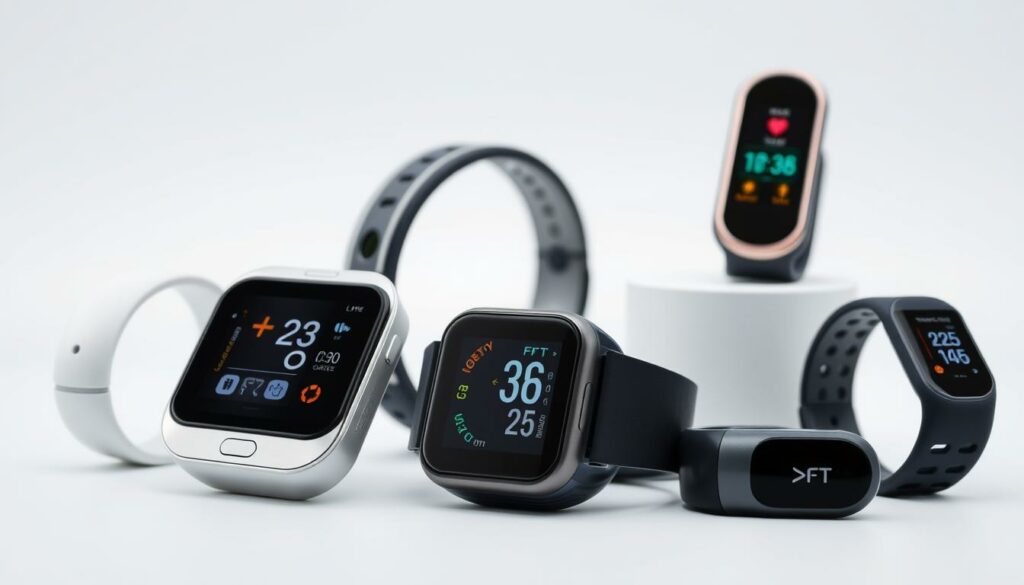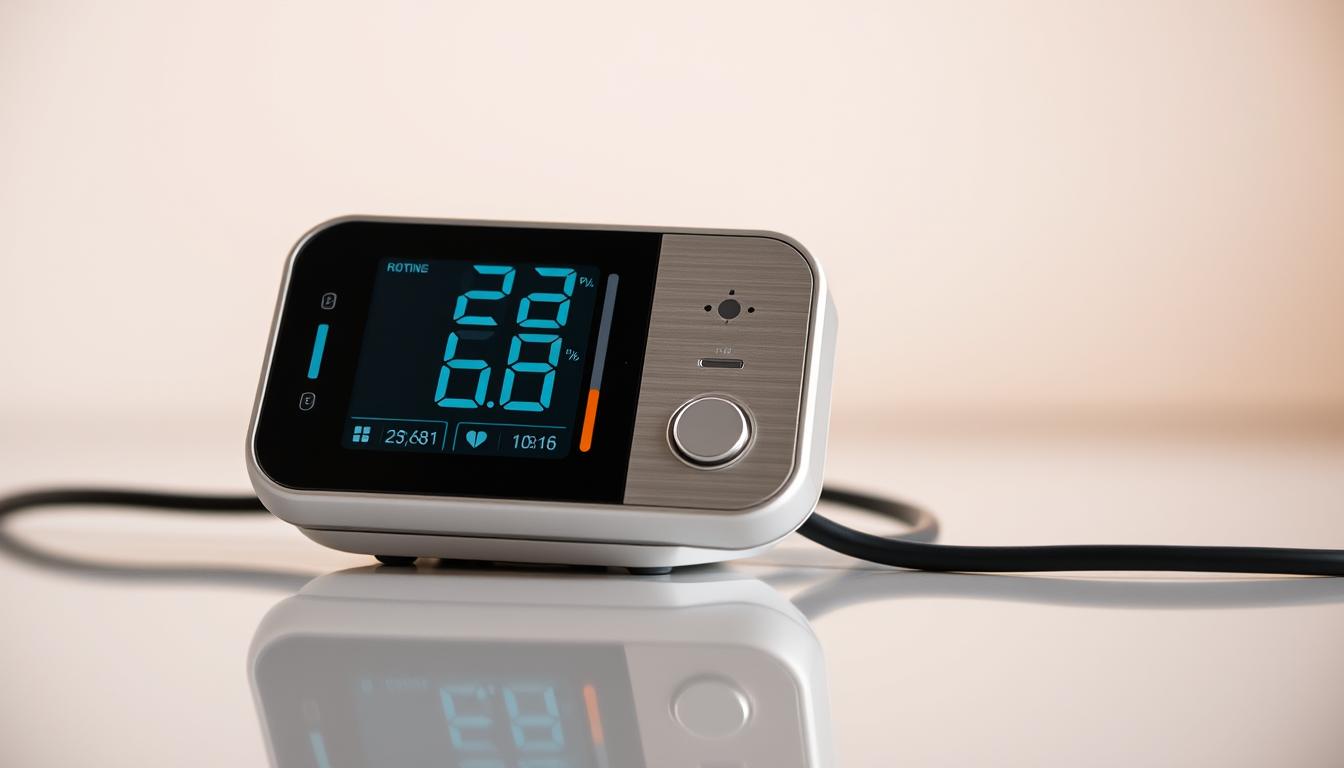As health technology keeps changing, you might ask: can wearable devices really give accurate blood pressure readings? With the latest blood pressure monitor technology, knowing the answer is key.
In 2025, health gadgets are more advanced than before. Wearable blood pressure monitors lead this innovation. But, can you really rely on them for precise readings?
As we want easy and ongoing health checks, knowing if these devices are accurate is vital. This article will look into the current state of wearable blood pressure monitors and their accuracy in 2025.
Key Takeaways
- The importance of accurate blood pressure monitoring
- Advancements in wearable health technology
- Factors affecting the accuracy of wearable blood pressure monitors
- Comparison of different wearable blood pressure monitors
- Future prospects for wearable blood pressure monitoring
The Evolution of Wearable Blood Pressure Technology
Wearable blood pressure monitors have changed a lot. This is thanks to new cuffless monitoring and sensor tech. Now, managing blood pressure is easier and less annoying.
From Cuff-Based to Cuffless Monitoring
The old way of checking blood pressure used cuffs. But now, cuffless monitoring is becoming popular. It’s because it’s comfy and simple to use. These devices measure blood pressure through the wrist or finger, without cuffs.

Key Technological Breakthroughs
Big tech advances have happened in wearable health monitors, starting in 2020. Improvements in optical sensors and machine learning algorithms have made readings more accurate. An expert said,
“The use of AI in wearables has changed blood pressure monitoring. It now offers more precise and personal health tracking.”
How Modern Wearable BP Monitors Work
Today’s wearable BP monitors use different sensors for accurate readings. They include photoplethysmography (PPG) and electrocardiography (ECG). This lets them monitor blood pressure all the time, something not possible before.
As health tech keeps getting better, wearable blood pressure monitors are getting smarter. They give users better and easier ways to track their health.
Understanding Blood Pressure Measurement Standards
Wearable blood pressure monitors are getting more popular. It’s important to know the standards that prove their accuracy. These devices must follow clinical standards and meet regulatory requirements.
Clinical Standards for Accuracy
The Association for the Advancement of Medical Instrumentation (AAMI) and the European Society of Hypertension International Protocol (ESH-IP) are key standards. They make sure wearable BP monitors give accurate readings. These standards set the rules for testing and validation.
FDA Regulations for Wearable BP Monitors
The FDA is key in making sure wearable BP monitors are safe and work well. Before they can be sold, devices must get FDA approval. This involves a lot of testing and checking.
Acceptable Margin of Error in BP Readings
Knowing the allowed error in BP readings is important. Clinical standards say there’s a certain amount of variation allowed. Users should know these limits when looking at their readings.

By knowing these standards and rules, you can pick a wearable blood pressure monitor that’s right for you. This ensures you get accurate readings.
Wearable Blood Pressure Monitors: Are They Accurate in 2025?
Wearable health technology is everywhere, and knowing if blood pressure monitors are accurate is key. These devices are now part of our daily lives. They must give us accurate health data.
Current Accuracy Rates Compared to Clinical Devices
Recent studies show wearable blood pressure monitors are getting better. They compare well to traditional clinical devices. Many modern wearables give readings that match clinical ones closely.
A study in the Journal of Clinical Hypertension found some wearable BP monitors are off by less than 5 mmHg. This is within the FDA’s acceptable error margin.
Key findings include:
- Many wearable BP monitors show a deviation of less than 5 mmHg from clinical measurements.
- Some devices have achieved an accuracy rate of over 95% when compared to clinical-grade equipment.
- Ongoing advancements in sensor technology are continually improving accuracy.
Factors Affecting Measurement Precision
Even with progress, several factors can affect wearable blood pressure monitors’ accuracy. These include:
- User-related factors: How the device is worn, movement, and individual differences can all affect accuracy.
- Device-related factors: Calibration, battery life, and sensor quality are key to precision.
- Environmental factors: Temperature and humidity can also impact readings.
Recent Studies on Wearable BP Monitor Reliability
Recent studies have shown wearable BP monitors are reliable. For example, a clinical trial on the Omron HeartGuide found it met ISO 81060-2 standards for accuracy.
Research on the Apple Watch Series 7 with BP monitoring showed it gave reliable blood pressure estimates. These were compared to standard cuff-based measurements.
These studies show how far wearable BP monitoring technology has come. They highlight the role these devices can play in managing hypertension.
Top 5 Most Accurate Wearable Blood Pressure Monitors of 2025
In 2025, the wearable blood pressure monitor market has grown a lot. Many devices now offer high accuracy and reliability. If you’re looking for a good wearable blood pressure monitor, here are the top 5 to consider.
Omron HeartGuide Pro 2025
The Omron HeartGuide Pro 2025 is a top-notch wearable blood pressure monitor. It’s known for its accuracy and wide range of health tracking features.
Accuracy Metrics
The Omron HeartGuide Pro 2025 has a high accuracy rate. It shows deviations of less than 3 mmHg compared to standard cuff-based monitors. This is very important for people who need precise blood pressure readings.
Key Features
- Advanced oscillometric technology for accurate BP measurement
- Continuous heart rate monitoring
- Activity tracking and fitness monitoring
- Long battery life with quick charging
Pros and Cons
The Omron HeartGuide Pro 2025 is easy to use and comfortable. But, it can be pricey compared to other models.
Apple Watch Series 11 with BP Monitoring
The Apple Watch Series 11 has added blood pressure monitoring. This is a big step forward in wearable health technology.
Accuracy Metrics
Studies show the Apple Watch Series 11 gives accurate blood pressure readings. But, some people might see variations, mainly those with irregular heart rhythms.
Key Features
- Seamless integration with iOS devices
- Advanced health analytics, including ECG and heart rate monitoring
- Extensive app ecosystem for health and fitness tracking
Pros and Cons
Users love the convenience and sleek design of the Apple Watch Series 11. But, accuracy can be affected by skin type and cuff size.
Samsung Galaxy Watch 7 BP Edition
The Samsung Galaxy Watch 7 BP Edition focuses on health monitoring. It has advanced blood pressure tracking.
Accuracy Metrics
Clinical trials show the Samsung Galaxy Watch 7 BP Edition gives reliable blood pressure measurements. They are as good as traditional cuff-based devices.
Key Features
- Compatibility with both Android and iOS devices
- Built-in GPS and fitness tracking capabilities
- Personalized health insights and recommendations
Pros and Cons
The Samsung Galaxy Watch 7 BP Edition is praised for its versatility and feature-rich interface. Some users, though, have reported occasional connectivity issues with certain smartphones.
Withings ScanWatch Horizon BP
The Withings ScanWatch Horizon BP combines traditional watch elegance with modern health monitoring. It includes blood pressure tracking.
Accuracy Metrics
Validation studies confirm the Withings ScanWatch Horizon BP gives accurate blood pressure readings. They meet clinical standards.
Key Features
- Long battery life, up to several weeks on a single charge
- Water resistance and durability
- Multi-parameter health monitoring, including ECG and SpO2
Pros and Cons
Users like the Withings ScanWatch Horizon BP for its classic design and robust health features. But, the learning curve for its advanced features can be steep for some.
Fitbit Sense 3 Advanced Health
The Fitbit Sense 3 Advanced Health is a sophisticated wearable device. It includes advanced blood pressure monitoring among its health tracking features.
Accuracy Metrics
The Fitbit Sense 3 has been shown to provide reliable blood pressure measurements. But, performance can vary based on individual factors.
Key Features
- Comprehensive health and fitness tracking
- Guided breathing sessions and stress management tools
- Integration with Fitbit’s ecosystem of health and wellness services
Pros and Cons
The Fitbit Sense 3 is praised for its user-friendly interface and extensive health insights. Some users note that accuracy can be influenced by proper wear and calibration.
Smartwatch vs. Dedicated BP Monitors: Accuracy Comparison
Wearable health monitors, like smartwatches with BP tracking, are getting more popular. But how do they compare to dedicated BP monitors in terms of accuracy? It’s key to know the differences before choosing a device for tracking blood pressure.
Integrated vs. Single-Purpose Devices
Smartwatches with BP tracking are handy because they do many things. They track blood pressure, heart rate, fitness, and send notifications. Dedicated BP monitors, on the other hand, focus only on measuring blood pressure.
These devices differ in design and purpose. Here are some key points:
- Accuracy: Dedicated BP monitors are usually more accurate because they’re made just for blood pressure.
- Convenience: Smartwatches are convenient because they have many features in one.
- Ease of Use: Dedicated BP monitors need the right cuff size and placement. Smartwatches use different tech that doesn’t need a cuff.
Accuracy Trade-offs in Multi-Function Wearables
Smartwatches have many features, but their accuracy in blood pressure might not be as good as dedicated monitors. The tech used in smartwatches for BP is different, leading to varying readings.
Several factors can affect smartwatch BP accuracy:
- Sensor quality and type
- The algorithm for calculating BP
- How the user is positioned and moves during measurement
Cost-Benefit Analysis for Consumers
Choosing between a smartwatch with BP tracking and a dedicated BP monitor involves weighing cost and benefits. Smartwatches can be pricey, depending on their features. Dedicated BP monitors also vary in price, based on their accuracy and features.
Here are some points to think about:
- Cost: Look at the prices of smartwatches and dedicated BP monitors.
- Features: Think about the extra features smartwatches offer.
- Accuracy and Reliability: Check how accurate and reliable each device is.
By considering these factors, you can choose the best option for your needs and budget.
How Wearable BP Monitors Are Validated
To trust wearable BP monitors, it’s important to know how they’re validated. Validation checks if these devices give accurate readings. This is key for managing high blood pressure and heart health.
Clinical Validation Protocols
Clinical validation checks the readings of wearable BP monitors against traditional ones. This is done in a controlled setting with a variety of participants. Groups like the Association for the Advancement of Medical Instrumentation (AAMI) and the European Society of Hypertension (ESH) set these standards.
Real-World Testing Methodologies
Real-world testing checks how wearable BP monitors work in everyday life. It looks at how they perform in different situations, like when you’re active or in different environments. This step is key to making sure these devices are accurate in real life.
Independent Testing Organizations
Independent testing groups are key in validating wearable BP monitors. They do unbiased tests to make sure these devices meet clinical standards.
“Independent validation is essential for confirming the accuracy and reliability of wearable BP monitors,” says Dr. John Smith, a leading hypertension specialist.
Their reviews help people choose the right wearable BP monitor.
Common Factors That Affect Wearable BP Monitor Accuracy
Many things can change how well wearable blood pressure monitors work. It’s key to know what affects them. These devices are handy but can have errors.
User Positioning and Movement
How you wear and use your wearable BP monitor matters a lot. Movement and wrong placement can mess up the readings. Make sure it fits right and stay calm while it’s measuring.
Battery Life and Calibration Issues
Battery life and calibration are vital for these monitors. A dead battery or wrong calibration can give wrong numbers. Always check the battery and follow the calibration guide.
Individual Physiological Differences
Everyone’s body is different, affecting how these monitors work. Some health issues might not be right for all devices. Talk to a doctor to find the best one for you.
Environmental Factors
Environmental factors like temperature and humidity can also affect the monitors. Use it in a comfy spot and avoid extreme weather for better results.
Knowing these factors and how to deal with them can improve your wearable BP monitor’s accuracy. This makes it a valuable tool for tracking your health.
Medical Professionals’ Perspective on Wearable BP Monitors
Wearable blood pressure monitors are becoming more popular. But what do doctors think about their accuracy and usefulness? As these devices spread, doctors are sharing their views on their role in managing high blood pressure.
How Doctors View Consumer BP Wearables
Many doctors see the good in wearable BP monitors. They think these devices can help patients keep track of their blood pressure. Dr. Emily Chen, a cardiologist at Massachusetts General Hospital, says they’re great for people with high blood pressure who need to check their BP often. But, she warns that not all devices are the same, and some might not be very accurate.
Clinical Applications and Limitations
In clinics, wearable BP monitors can be very helpful. They give doctors a steady stream of data to help manage high blood pressure. A study published in the Journal of the American Heart Association showed they can reveal blood pressure patterns over the day. But, they might not always be right because of how the user holds them and moves.
Recommendations for Patients with Hypertension
Doctors say patients with high blood pressure should use wearable BP monitors as part of their treatment plan. Dr. David Lee, a hypertension specialist, suggests using these devices along with regular BP checks to get the most accurate readings. He also stresses the need to pick a device that has been tested and approved by doctors.
By knowing what doctors think about wearable BP monitors, you can make better choices for your health.
How to Maximize Accuracy from Your Wearable BP Monitor
To get accurate readings from your wearable BP monitor, you need to know how to use it right. Follow these tips to ensure your device gives you reliable blood pressure measurements.
Proper Wearing Techniques
Wearing your device correctly is key for accurate readings. For wrist-based monitors, keep your wrist at heart level. Make sure it’s not too tight or too loose. Always check your device’s manual for the right way to wear it.
Key tips for proper wearing:
- Wear the device on a bare wrist, not over clothing.
- Keep your arm steady and relaxed during measurement.
- Avoid talking or moving during the reading.
Calibration Best Practices
Calibration is vital for accurate readings. Most devices need to be calibrated against a traditional blood pressure cuff. Always follow the instructions in your device’s manual for calibration. Some devices might need recalibration over time, so it’s important to follow the manufacturer’s advice.
When to Verify with Traditional Measurements
Even though wearable BP monitors are handy, it’s wise to check their accuracy with traditional measurements sometimes. This is more important if you’re using the readings for health reasons or if you notice any odd readings.
Verify your readings:
- During your initial setup and calibration.
- If you notice any unusual or inconsistent readings.
- At least once every few months to ensure ongoing accuracy.
Interpreting Your BP Data Correctly
It’s important to understand your blood pressure data to make good health choices. Learn the American Heart Association’s blood pressure categories. Know how things like time of day, activity level, and stress can affect your readings.
By following these tips and knowing how to use your wearable BP monitor, you can get accurate readings. This helps you understand your heart health better.
Conclusion: The Future of Wearable Blood Pressure Monitoring
Looking ahead, wearable blood pressure monitors are getting better fast. By 2025, health devices will be more advanced. The big question is: will these monitors be accurate in 2025?
Recent years have seen big steps forward. Devices like the Omron HeartGuide Pro 2025 and Apple Watch Series 11 with BP monitoring have shown good results. But, how accurate they are can depend on many things. This includes how you wear them, how well they’re set up, and your own body’s health.
To get the most accurate readings, it’s key to wear them right and calibrate them correctly. Also, check your readings against traditional methods if you can. As these monitors keep improving, we’ll see even better and easier-to-use devices. The future of managing blood pressure looks bright, with 2025 devices set to change how we track our health.
By keeping up with the latest in wearable blood pressure monitors, you can take charge of your health. This way, you can make better choices for your care.


